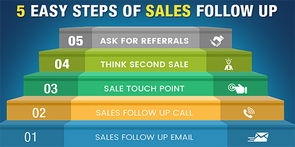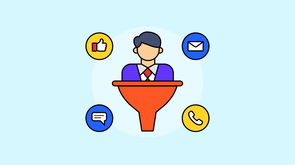There is an underlying confusion regarding the importance of follow-up emails in the industry. Are they intrusive? Will the consumer even bother to open them, or will it fill the bin?
Well, here’s a stat to calm your fears: 70% of all unanswered sales related email chains are the ones that were not followed up with a second email. (Source – yesware.com)

Consumers are targeted on a daily basis with automated advertisement emails and spam-filled links (8.6 billion emails are sent out, each day!). Which is why they cannot be blamed for ignoring yet another marketing email.
However, this is exactly why marketers should follow up with potential clients. A second email lets the consumer know that the first email wasn’t an automated bot message, but one specifically crafted for them.
New Ideas For Follow Up Emails
Generic follow-up emails are as good as the ones that weren’t sent. There is a need to be quick, straightforward, and human, if you are to succeed at converting a potential lead.
In the next paragraphs, we’ll explore multiple ideas that ensure that the follow-up emails end up converting consumers that failed to convert with your initial email outreach. Let’s get started:
Customization Is Key
Generic emails not only fail to yield a respectable response rate, but they also come across as a lazy effort to fool the recipient into replying.
Customization not only signals work you’ve invested in crafting an email specifically for the client, but also resonates greatly with their needs, which is more likely to elicit a response.
For instance, you market a workflow automation application that is aimed to streamline work processes. Despite the application being useful for a marketing professional, a boiler template aimed at a professional who receives dozens of marketing emails a day is bound to find its way to the bin.
Conversely, if what you are offering can be molded to help the consumer solve their problems, such as explaining how they can use it to create automated triggers for emails that are yet to be responded to, you increase your chances of getting a reply back manifold.
After all, email customization and personalization increases click-through and conversion rates by more than 10% respectively.
Keep It Short And Simple
While email marketing as a whole should adhere to shorter text lengths (lengthy emails don’t appeal to the consumers), follow-up emails should particularly live by the KISS (keep it short and simple) rule.
However, this doesn’t translate to doing away with the small talk required to initiate a conversation. Marketers should make it a point to respect the time of the consumer by doing away with the details embedded in the initial outreach, and coming directly to the point of the email – that is following up on the previous conversation.
Be Creative With Your Subject Line
As the first piece of content that distinguishes your email from all others, subject lines determine whether your email is going to be opened or not.
This is more important in the case of follow-up emails, as they are following up on the previous outreach effort, and must pertain to the situation and consequence of the initial email.
For instance, if you’re following up from a call or meeting that you had with the client, the subject line should read something like: ‘Next Step.’ By incorporating this subject line in their follow-up methods a company benefited with an increased open rate of 70.5%, and a reply rate of 49.6%.
In case the initial email failed to materialize a conversation, an email subject line like ‘I forgot to mention…’ is likely to perform better than its predecessor. By adding a human element to the email, it depicts a natural (and non-salesy) side, while subconsciously paving the way for you to present more benefits the consumer can derive from the product.
Subtle Humor Is Always Welcome

Marketing involves playing with the psychology of the masses, so why not introduce it in your follow up emails?
However, there is a fine line between being funny and unprofessional. Don’t subject your potential customers to unprofessional humor, or ask them to select options that you have specified in your email as that comes across as gimmicky.
If you’re unsure about how to walk the fine line, it pays to stick to a professional email.
Adding Context Can Work Wonders
You can add flair and humor to your subject line to entice the consumer, but there needs to be something in your follow up email that distinguishes you from the average marketer trying to reach the monthly goal.
Give your emails context to weigh it down with additional value. There are many ways to add context and value, such as:
- Any interaction in the past, be it a social network chat or a blog comment.
- Any mutual connection, or common points.
- If you lack such ‘connectors,’ it pays to take a look at your customer’s social media accounts to gauge how to approach this person.
Adding context can bear fruits for your outreach efforts like it did for Jason Zook. Jason utilized such connecting points to enhance follow-up email customization to a great effect; securing 75% of his leads.
Provide Them With Valuable Solutions
There has been a distinct shift in consumer behavior over the last decade. Consumers prefer valuable content which provides them solutions to their specific problems.
What’s the problem you’re solving? That’s the question you should ask yourself before you begin typing the follow-up mail. Before you even offer your service or promote your product, focus on solving the problems your target audience might be facing.
Aligning your follow-up email with customer problems and relevant solutions is bound to lead to increased conversions.
Leverage Social Proof
Social proof comes in handy almost anywhere. Use it in your content marketing efforts, display it on your landing page, and make sure you use it in your follow-up email template.
While an overwhelming majority of Americans admit going through the reviews before making a purchase, what’s more surprising is that 84% of people admit to trusting social proof as much as a personal recommendation.
Here is Tim Soulo’s attempt at utilizing social proof for his email outreaching efforts:

Feel free to sprinkle previous achievements throughout your follow up email. Perplexed on what to include? Here are a few things you may include:
- Previous achievements regarding the service you offer
- How your product has helped bring about a change for another consumer
- Customer reviews, ratings, or testimonials
- Success case studies of the brands you’ve worked with
Consumers React To Call To Actions
Maybe you’re a little confused seeing a CTA placed in a follow-up email. However, since there’s no denying the importance and vitality call-to-action statements and buttons hold for your online presence, you should incorporate them where possible.
Be it a landing page, or a guest blog – a CTA is considered an important psychological trigger that pushes the consumer to convert. So why devoid follow-up emails from such an effective component?
There is no need for intricate wordplay; a simple question is enough. Something around the lines of: “Let’s talk about the conversation we had earlier – a short call will do. How does your calendar look this Wednesday?”
There is a reason why I added a question as a call-to-action. Emails that consist of a few questions (ranging from 1 to 3 questions) are likely to achieve 50% more responses than emails that don’t question the consumer.
A follow-up email call-to-action mostly revolves around getting the client to call, chat with the marketers, or subscribe/download/sign-up to the required program. Add a question to entice the consumer. After all, you’ll never get a yes, if you don’t ask.
Respect Their Time
Have you ever received a follow-up email, but couldn’t figure out as to what product or service was being referred to? If you have, you know that the confusion usually ends with the email being deleted.
Respecting the consumer’s time is one of the principle rules of email marketing as a whole; particularly follow-up marketing, which further evolves a previous outreach or conversation.
Which is why it is advised to have the original email embedded in the follow-up email.
Another aspect of respecting the consumer’s time is being patient before sending out the follow-up email. Sending an email on Friday, and lining up the follow-up on Monday is naïve and repelling.
Respect holiday and weekend schedules, and only proceed with it once you’re sure that a follow-up is necessary.
Scheduling your follow-ups effectively, from the initial to the goodbye email will help you see greater responses as well.
Automate Your Follow-Up Process
Advanced technological advancements in the marketing and advertisement arena have led us towards applications that make it possible to not just save and create emails, but also track their performance and further customize outreach efforts with minor tweaks rather than complete overhauls.
Automation enables marketers to efficiently allocate their time into strategizing future courses of action, rather than supervising monotonous and mundane tasks. With the pace at which the industry is changing, automation has become an indispensable asset for marketers going forward.
Surveys show that you should send a follow up email 3-4 days after initial email, or up to one week later. Waiting longer could make the recipient forget what the initial email was about, while sending a follow up the day after the first email is just spammy and annoying.
If you are using a tool for outreach or just plain ol’ Gmail, you can easily set up reminders and get a notification to send out the follow up on a certain day, or even have it completely automated and sent automatically.
Conclusion
Marketers are inclined to think follow-up emails are unwelcomed and annoying. That’s only true if your approach is to provide fluff without value to the consumer.
If the consumers are provided with a valuable, actionable follow-up email that is customized to their problems, the open and reply rate increases substantially.




![Sales follow up: 7 Tried & tested strategies [8 templates inside]](/mm-images/sales-follow-up-bi30y6y5.jpg?width=295)


There is an underlying confusion regarding the importance of follow-up emails in the industry. Are they intrusive? Will the consumer even bother to open them, or will it fill the bin?
Well, here’s a stat to calm your fears: 70% of all unanswered sales related email chains are the ones that were not followed up with a second email. (Source – yesware.com)
Consumers are targeted on a daily basis with automated advertisement emails and spam-filled links (8.6 billion emails are sent out, each day!). Which is why they cannot be blamed for ignoring yet another marketing email.
However, this is exactly why marketers should follow up with potential clients. A second email lets the consumer know that the first email wasn’t an automated bot message, but one specifically crafted for them.
New Ideas For Follow Up Emails
Generic follow-up emails are as good as the ones that weren’t sent. There is a need to be quick, straightforward, and human, if you are to succeed at converting a potential lead.
In the next paragraphs, we’ll explore multiple ideas that ensure that the follow-up emails end up converting consumers that failed to convert with your initial email outreach. Let’s get started:
Customization Is Key
Generic emails not only fail to yield a respectable response rate, but they also come across as a lazy effort to fool the recipient into replying.
Customization not only signals work you’ve invested in crafting an email specifically for the client, but also resonates greatly with their needs, which is more likely to elicit a response.
For instance, you market a workflow automation application that is aimed to streamline work processes. Despite the application being useful for a marketing professional, a boiler template aimed at a professional who receives dozens of marketing emails a day is bound to find its way to the bin.
Conversely, if what you are offering can be molded to help the consumer solve their problems, such as explaining how they can use it to create automated triggers for emails that are yet to be responded to, you increase your chances of getting a reply back manifold.
After all, email customization and personalization increases click-through and conversion rates by more than 10% respectively.
Keep It Short And Simple
While email marketing as a whole should adhere to shorter text lengths (lengthy emails don’t appeal to the consumers), follow-up emails should particularly live by the KISS (keep it short and simple) rule.
However, this doesn’t translate to doing away with the small talk required to initiate a conversation. Marketers should make it a point to respect the time of the consumer by doing away with the details embedded in the initial outreach, and coming directly to the point of the email – that is following up on the previous conversation.
Be Creative With Your Subject Line
As the first piece of content that distinguishes your email from all others, subject lines determine whether your email is going to be opened or not.
This is more important in the case of follow-up emails, as they are following up on the previous outreach effort, and must pertain to the situation and consequence of the initial email.
For instance, if you’re following up from a call or meeting that you had with the client, the subject line should read something like: ‘Next Step.’ By incorporating this subject line in their follow-up methods a company benefited with an increased open rate of 70.5%, and a reply rate of 49.6%.
In case the initial email failed to materialize a conversation, an email subject line like ‘I forgot to mention…’ is likely to perform better than its predecessor. By adding a human element to the email, it depicts a natural (and non-salesy) side, while subconsciously paving the way for you to present more benefits the consumer can derive from the product.
Subtle Humor Is Always Welcome
Marketing involves playing with the psychology of the masses, so why not introduce it in your follow up emails?
However, there is a fine line between being funny and unprofessional. Don’t subject your potential customers to unprofessional humor, or ask them to select options that you have specified in your email as that comes across as gimmicky.
If you’re unsure about how to walk the fine line, it pays to stick to a professional email.
Adding Context Can Work Wonders
You can add flair and humor to your subject line to entice the consumer, but there needs to be something in your follow up email that distinguishes you from the average marketer trying to reach the monthly goal.
Give your emails context to weigh it down with additional value. There are many ways to add context and value, such as:
Adding context can bear fruits for your outreach efforts like it did for Jason Zook. Jason utilized such connecting points to enhance follow-up email customization to a great effect; securing 75% of his leads.
Provide Them With Valuable Solutions
There has been a distinct shift in consumer behavior over the last decade. Consumers prefer valuable content which provides them solutions to their specific problems.
What’s the problem you’re solving? That’s the question you should ask yourself before you begin typing the follow-up mail. Before you even offer your service or promote your product, focus on solving the problems your target audience might be facing.
Aligning your follow-up email with customer problems and relevant solutions is bound to lead to increased conversions.
Leverage Social Proof
Social proof comes in handy almost anywhere. Use it in your content marketing efforts, display it on your landing page, and make sure you use it in your follow-up email template.
While an overwhelming majority of Americans admit going through the reviews before making a purchase, what’s more surprising is that 84% of people admit to trusting social proof as much as a personal recommendation.
Here is Tim Soulo’s attempt at utilizing social proof for his email outreaching efforts:
Feel free to sprinkle previous achievements throughout your follow up email. Perplexed on what to include? Here are a few things you may include:
Consumers React To Call To Actions
Maybe you’re a little confused seeing a CTA placed in a follow-up email. However, since there’s no denying the importance and vitality call-to-action statements and buttons hold for your online presence, you should incorporate them where possible.
Be it a landing page, or a guest blog – a CTA is considered an important psychological trigger that pushes the consumer to convert. So why devoid follow-up emails from such an effective component?
There is no need for intricate wordplay; a simple question is enough. Something around the lines of: “Let’s talk about the conversation we had earlier – a short call will do. How does your calendar look this Wednesday?”
There is a reason why I added a question as a call-to-action. Emails that consist of a few questions (ranging from 1 to 3 questions) are likely to achieve 50% more responses than emails that don’t question the consumer.
A follow-up email call-to-action mostly revolves around getting the client to call, chat with the marketers, or subscribe/download/sign-up to the required program. Add a question to entice the consumer. After all, you’ll never get a yes, if you don’t ask.
Respect Their Time
Have you ever received a follow-up email, but couldn’t figure out as to what product or service was being referred to? If you have, you know that the confusion usually ends with the email being deleted.
Respecting the consumer’s time is one of the principle rules of email marketing as a whole; particularly follow-up marketing, which further evolves a previous outreach or conversation.
Which is why it is advised to have the original email embedded in the follow-up email.
Another aspect of respecting the consumer’s time is being patient before sending out the follow-up email. Sending an email on Friday, and lining up the follow-up on Monday is naïve and repelling.
Respect holiday and weekend schedules, and only proceed with it once you’re sure that a follow-up is necessary.
Scheduling your follow-ups effectively, from the initial to the goodbye email will help you see greater responses as well.
Automate Your Follow-Up Process
Advanced technological advancements in the marketing and advertisement arena have led us towards applications that make it possible to not just save and create emails, but also track their performance and further customize outreach efforts with minor tweaks rather than complete overhauls.
Automation enables marketers to efficiently allocate their time into strategizing future courses of action, rather than supervising monotonous and mundane tasks. With the pace at which the industry is changing, automation has become an indispensable asset for marketers going forward.
Surveys show that you should send a follow up email 3-4 days after initial email, or up to one week later. Waiting longer could make the recipient forget what the initial email was about, while sending a follow up the day after the first email is just spammy and annoying.
If you are using a tool for outreach or just plain ol’ Gmail, you can easily set up reminders and get a notification to send out the follow up on a certain day, or even have it completely automated and sent automatically.
Conclusion
Marketers are inclined to think follow-up emails are unwelcomed and annoying. That’s only true if your approach is to provide fluff without value to the consumer.
If the consumers are provided with a valuable, actionable follow-up email that is customized to their problems, the open and reply rate increases substantially.
Mehul Shah
Mehul ShahMehul Shah, a digital marketer with an uncommon funny bone and a knack for perfection. Mehul has been writing about how Salesmate CRM helps small and medium business, for a long time now! He is a digital marketer and a geek in the Inbound marketing, who likes to spend most of his time researching ways technology is influencing your daily life (positively).